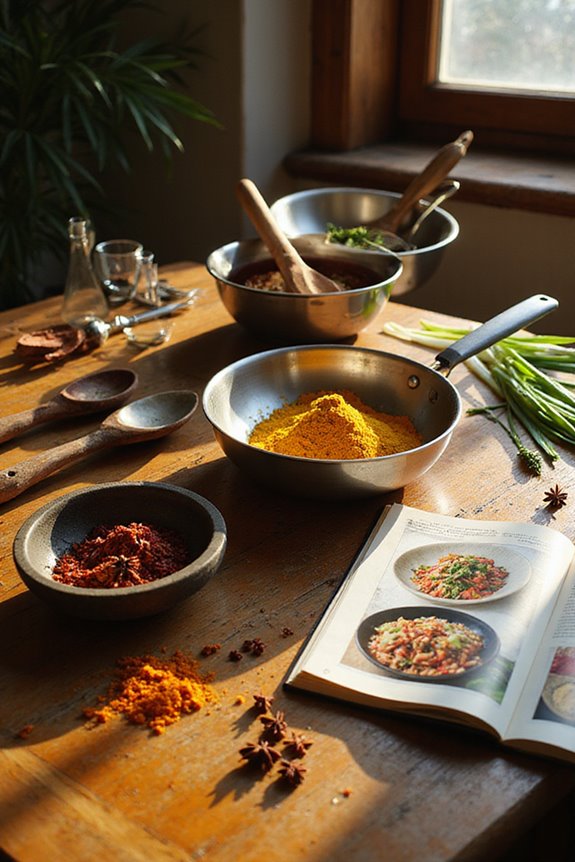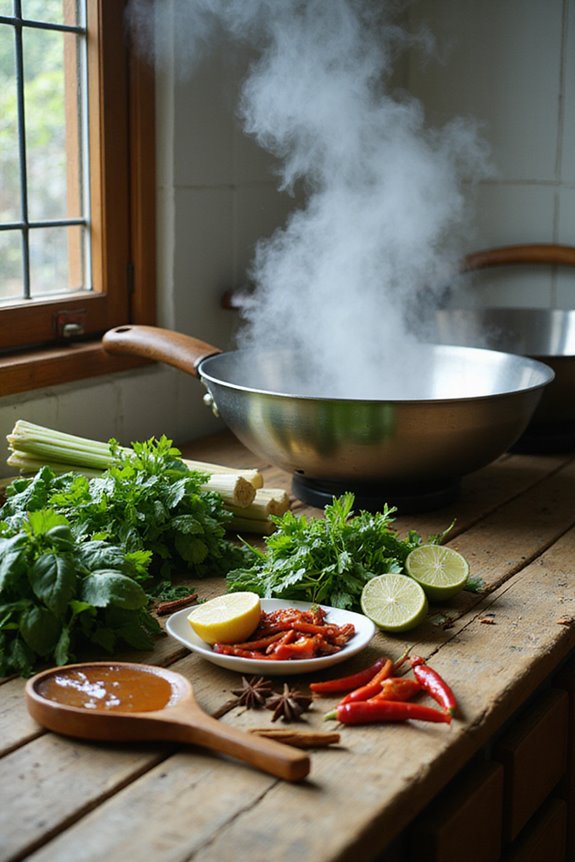Making traditional Burmese dishes is a delightful adventure for our taste buds! We can start with essential ingredients like turmeric and lemongrass for flavor. Let’s whip up signature dishes like Mohinga, a breakfast noodle soup, or Lahpet Thoke, a tangy tea leaf salad. Don’t forget to try the fragrant Danbauk biryani for festive gatherings! With a sprinkle of humor and a dash of joy, we’ll bring these magical recipes to life. Stay with us; there’s more delightful cooking to explore!
Key Takeaways
- Begin with essential ingredients like turmeric, garlic, lemongrass, and unique vegetables such as tamarind and eggplant for authentic flavor.
- Prepare signature dishes such as Mohinga (fish noodle soup) and Lahpet Thoke (pickled tea leaf salad) to showcase Burmese cuisine.
- For Mohinga, extract broth by boiling fish with spices, and thicken with toasted chickpea or rice flour for a velvety texture.
- Cook Burmese Chicken Curry using chicken thighs, sautéed aromatics, essential spices, and a mix of fish sauce and palm sugar for rich flavor.
- Create Lahpet Thoke by combining fermented tea leaves, roasted peanuts, fried garlic, and optional ingredients for a savory salad experience.
Essential Ingredients for Burmese Cooking
When it comes to creating delightful Burmese dishes, having the right ingredients in our pantry is like having a treasure chest full of magical flavors! To begin our culinary adventure, we’ll need essential spices that bring warmth and depth, like turmeric, cumin, and ginger. Fresh ingredients, like garlic and lemongrass, will elevate our dishes to new heights. Additionally, incorporating freeze-dried herbs can ensure we always have robust flavors on hand, even when fresh ingredients are not available. Essential vegetables such as tamarind and eggplant will add that unique twist we’re looking for. For our protein sources, we can rely on freshwater fish or chickpeas to keep our tummy happy. Let’s gather these goodies and create a feast that’ll have friends and family coming back for seconds. Happy cooking!
Signature Dishes to Prepare
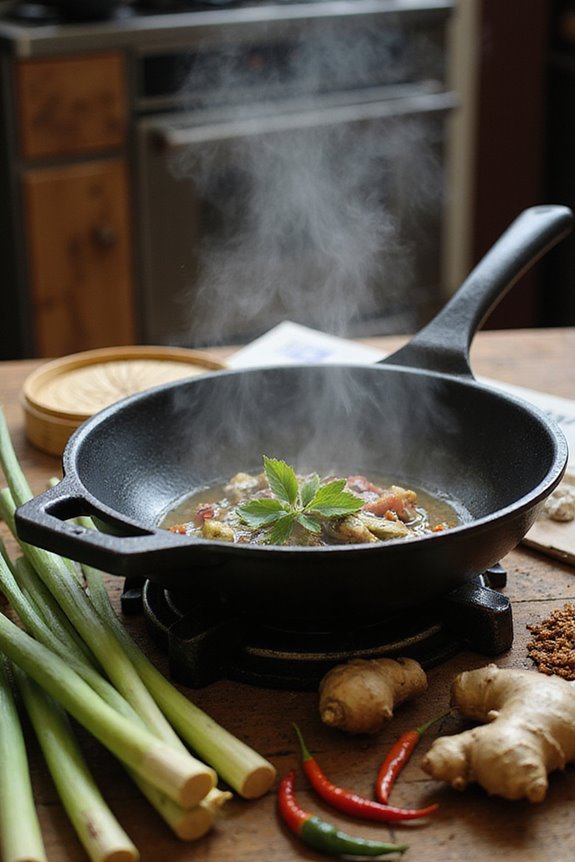
Get ready to commence on a delicious journey through five iconic Burmese dishes that’ll make our taste buds dance!
- Mohinga: This aromatic fish noodle soup is a breakfast staple, filled with rich fish stock flavored with delightful Burmese spices.
- Lahpet Thoke: A vibrant pickled tea leaf salad, mixing sour and savory elements, and brings family together during celebrations.
- Burmese Fried Chicken: Crispy chicken seasoned just right, served with a tangy tamarind sauce—perfect for snacking!
- Ohn No Kauk Swé: Indulge in creamy coconut noodles that warm the soul.
- Danbauk: This fragrant chicken biryani with spices is the life of any gathering!
Each dish has its cultural significance, making our culinary adventure truly magical! Additionally, incorporating elements like savory flavor profiles can elevate your experience with traditional dishes, blending tastes that resonate with the diverse essence of Burmese cuisine.
Preparation Techniques for Moh Hin Gha
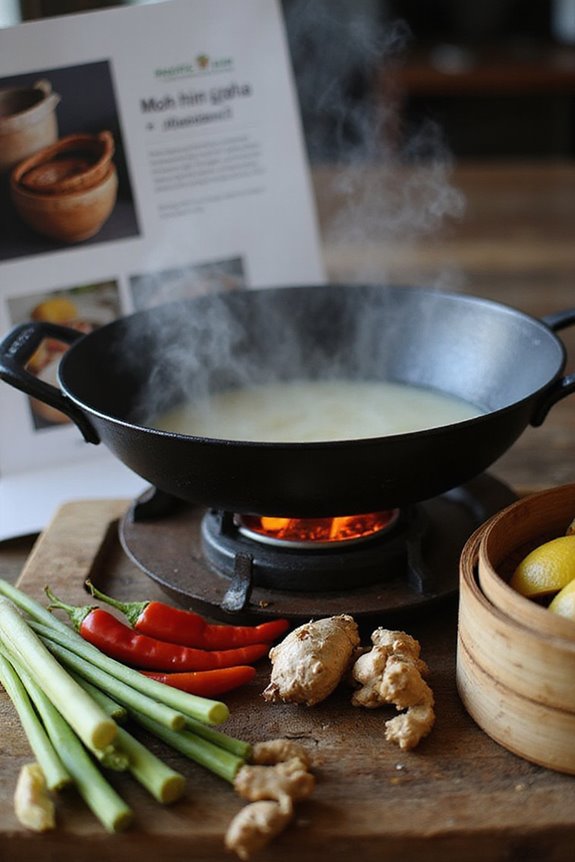
Ready to plunge into the delightful world of preparing Moh Hin Gha? Let’s immerse ourselves in some magical techniques!
Broth Extraction
Start with catfish or seabass. Boil it with water, turmeric, lemongrass, ginger, garlic, and bay leaves for a rich foundation. Don’t forget that little sprinkle of shrimp paste for umami goodness!
Spice Layering
Next, let’s build our flavor! Sauté minced garlic, ginger, and onions in oil. Add ground turmeric, paprika, and a dash of pepper for those cozy, warm vibes. Additionally, the even heat distribution during cooking will help enhance the flavor profile of the dish.
Finally, embrace the art of thickening! Gradually stir in your toasted chickpea or rice flour for that velvety soup. Let’s make dinner a flavorful gathering, where every bowl is a hug in disguise!
Cooking the Perfect Burmese Chicken Curry
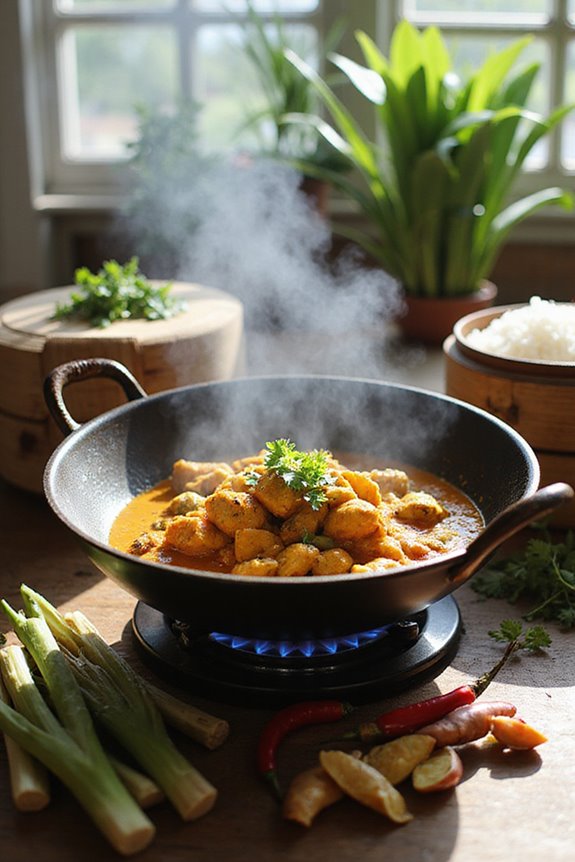
Burmese chicken curry is a delightful dish that’s sure to bring warmth to any meal—like a cozy blanket on a chilly evening! To start, we’ll use chicken thighs for tender bites. Let’s blend a magical mix of essential spices—madras curry powder, turmeric, ground ginger, and chili powder.
Next, we’ll sauté onions, garlic, and lemongrass to release those fragrant oils. To balance our curry, we’ll mix fish sauce and palm sugar for a truly authentic taste.
Don’t forget the tomatoes—they make the gravy rich and tangy!
As we simmer, the curry thickens beautifully, inviting everybody to the table. Serve it hot with fluffy coconut rice. Additionally, cooking with pressure cookers significantly reduces cooking time, allowing you to enjoy this dish even on busy days. Let’s create this masterpiece together and celebrate our success!
Crafting Lahpet Thoke: The Pickled Tea Leaf Salad
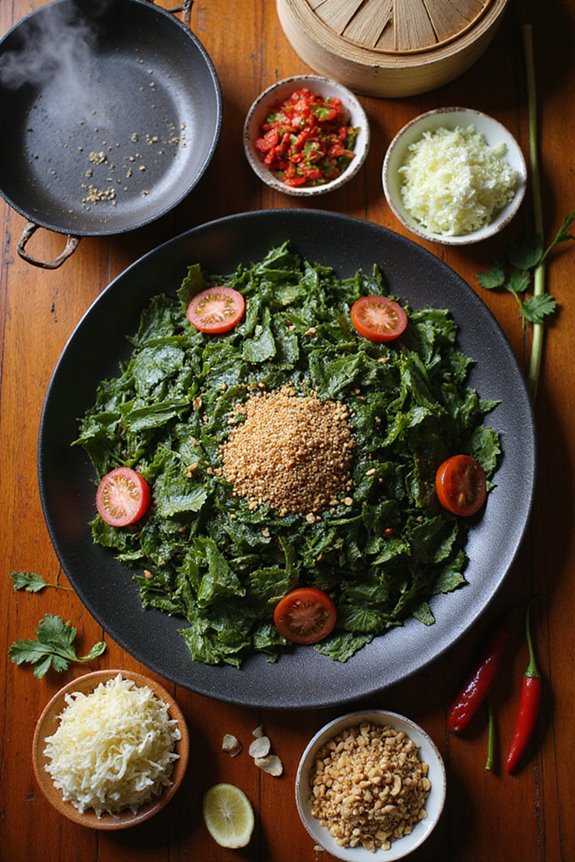
There’s something truly delightful about crafting Lahpet Thoke, the pickled tea leaf salad that brings a burst of flavor to our plates! To start, we’ll mix together our central ingredient, fermented tea leaves, with some roasted peanuts and sesame seeds for crunch. Don’t forget those crunchy fried garlic chips and our carefully adjusted chopped green chilies for that perfect spicy kick!
For some magical ingredient variations, we can add shredded cabbage for freshness or juicy tomatoes for sweetness. Feeling fancy? Toss in shrimp floss or a dash of fish sauce for an extra umami boost. A carbon steel wok is ideal for preparing the garlic chips to achieve that crispy texture. Serve it up in a communal bowl, and let’s enjoy this traditional Burmese dish, perfect for any gathering!
Making Danbauk: A Traditional Burmese Biryani
After crafting our delightful Lahpet Thoke, it’s time to turn our attention to another traditional favorite: Danbauk, a magical take on biryani that’ll make your taste buds dance with joy! Originating from Burmese culinary traditions, Danbauk is influenced by the Persian “dum pukht” technique. So, let’s gather our ingredients:
- Skinless chicken thighs, marinated with yogurt and a spice mix
- Basmati rice, soaked and parboiled
- Flavorful add-ins like peas, cashew nuts, and saffron
Layer marinated chicken and rice in a pot, cover it up, and cook on low heat for about 45 minutes. The dish embodies rich flavor and togetherness! Whether it’s a celebration or a cozy dinner, Danbauk variations always bring us closer! Don’t forget to pair your meal with Korean BBQ flavors to balance the richness of the dish.
Noodle Soups: Creating Khao Soi
When you’re in the mood for a comforting bowl of noodle soup, Khao Soi is like wrapping yourself in a warm, delicious blanket! Let’s kick off our Khao Soi adventure with some essential ingredients: medium-thickness rice or egg noodles, tender marinated chicken, and rich coconut milk—a magical combo! For the broth, we’ll sauté onion, garlic, and ginger, then mix in spices like turmeric and chili powder to boost that flavor profile.
Don’t forget, we can customize with Khao Soi variations, adding veggies or fried onions for extra crunch. Once we’ve cooked our noodles, we’ll load them into bowls and generously ladle the hot soup over the top. Finish with fresh lime and cilantro for that delightful zing! Enjoy every spoonful!
Tips for Serving and Garnishing Burmese Meals
Serving and garnishing traditional Burmese meals can be a delightful experience filled with warmth and communal enjoyment. Let’s set the scene!
- Table Setting: Gather ‘round a low, round table sitting on mats to immerse in the communal dining vibe.
- Food Presentation: Serve hearty dishes in small, deep bowls—this promotes coziness rather than formality.
- Elderly Respect: Remember, we serve our elders first, showing our appreciation.
- Garnishing: Elevate your meals with fresh herbs and fried garlic for that extra zing.
With proper table etiquette, we can share delicious curries, rice, and delightful tea leaf salad while enjoying the flavorful balance of sour, spicy, bitter, and sweet. So, let’s dig in and create magical memories together!
Frequently Asked Questions
What Kitchen Tools Are Essential for Cooking Burmese Dishes?
When we explore Burmese cuisine, it’s like opening a treasure chest! Crucial kitchen tools include a non-stick deep fry pan and mortar, both essential for cooking techniques and ingredient preparation that bring our flavors to life together.
How Can I Adjust Spice Levels in Burmese Recipes?
When we’re adjusting spice levels in Burmese recipes, we can focus on spice balance and flavor intensity. By tasting as we go, we’ll achieve that perfect combination that suits our collective palate beautifully.
Where Can I Find Authentic Burmese Ingredients?
Finding authentic Burmese ingredients can feel like a delightful treasure hunt. We’ve discovered lovely Burmese markets and reliable online suppliers that bring the flavors of home right to our kitchens, connecting us to our culinary heritage.
How Do I Store Leftovers From Burmese Meals?
When it comes to leftover storage from our meal prep, we should seal them in airtight containers and refrigerate. Let’s consume them within a few days to keep enjoying our delicious dishes safely!
Can I Substitute Any Ingredients in Traditional Burmese Recipes?
When it comes to ingredient variations in traditional Burmese recipes, we can certainly embrace substitutions! These adaptations not only reflect an understanding of cultural significance but also invite everyone to savor and feel at home in culinary creativity.




